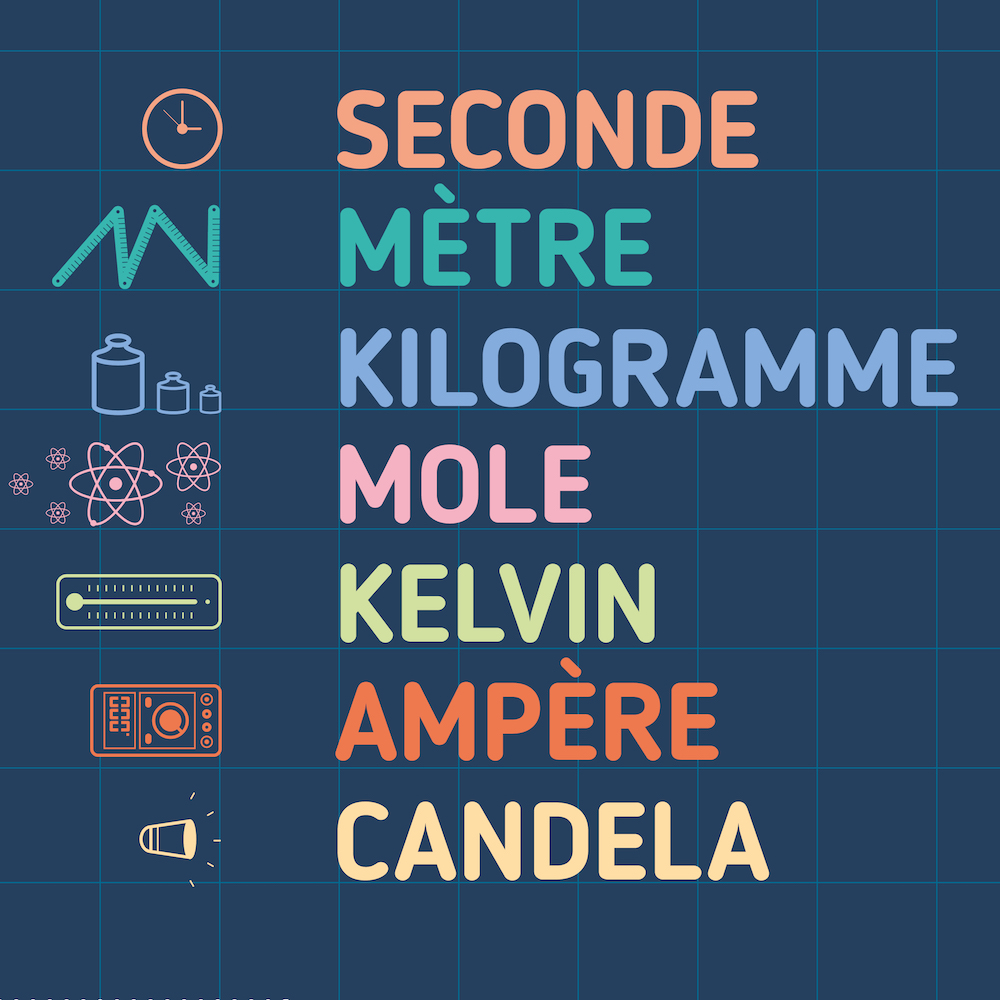Various / Divers
ENGLISH :
In this category you will find all the notes that are out of scope of the other existing categories, but which still concern mathematics and physics.
FRENCH :
Dans cette catégorie vous trouverez tous les billets qui sont hors champs des autres catégories existantes, mais qui concernent toujours les mathématiques et physiques.
-
The new units / Les nouvelles unités
- Par entropy-fluid
- Le 18/11/2018
- Dans Various / Divers
IN ENGLISH :
Here we will see the international units that have changed their definition, and those that have not changed.
The new units :
The ampereOld definition:
"An ampere is the intensity of a constant current which, if it is maintained in two linear and parallel conductors, of infinite lengths, of negligible sections and one meter apart in a vacuum, produces a force between these two conductors. linear equal to 2 × 10 ^ -7 newton per meter. "New definition:
"The ampere, A, is the unit of electric current, its value is defined by setting the numerical value of the elementary charge to exactly 1,602 176,634 × 10 ^ -19 when expressed in ampere-second, which corresponds to to coulombs."The kelvin
Old definition:
"Kelvin, a unit of thermodynamic temperature, is the fraction 1 / 273.16 of the thermodynamic temperature of the triple point of water."New definition:
"Kelvin, K, is the thermodynamic unit of temperature; its value is defined by setting the numerical value of the Boltzmann constant to exactly 1.380 649 × 10 ^ -23 when it is expressed in s⁻²m²kgK⁻¹, which corresponds to JK⁻¹."The mole
Old definition:
The mole is the amount of matter in a system containing as many elementary entities as there are atoms in 0.012 kilograms of carbon.New definition:
The mol, mol, is the unit of matter quantity of a specific elemental entity, which may be an atom, a molecule, an ion, an electron, or any other particular particle or group of these particles; its value is defined by setting the numerical value of the Avogadro number to exactly 6,022 140 \ 76 10 ^ 23 when expressed in mol⁻¹.
Units who do not change.
The second :
"The second, s, is the unit of duration; its value is defined by fixing the value of the number of periods of the radiation corresponding to the transition between the two hyperfine levels of the ground state of the cesium 133 atom at the temperature of the absolute zero to exactly 9 192 631 770 when it is expressed in s⁻¹."The meter :
"The meter, m, is the unit of length; its value is defined by fixing the value of the speed of light in a vacuum at exactly 299 792 458 when it is expressed in m s⁻¹."The candela:
"The candela, cd, is the unit of luminous intensity in a given direction; its value is defined by fixing the numerical value of the energy intensity of a monochromatic radiation of frequency 540 × 10 ^ 12 s⁻¹ (hertz) to exactly 683 when it is expressed in s³⋅m⁻²⋅kg⁻¹⋅ cd⋅sr, or cd⋅sr⋅W⁻¹, which corresponds to lm⋅W⁻¹."
IN FRENCH :
Ici, nous allons voir les unités internationales qui ont changés de définition, et celles qui n'ont au contraire pas changé.
Les nouvelles unités :
L'ampèreAncienne définition :
"Un ampère est l'intensité d'un courant constant qui, s'il est maintenu dans deux conducteurs linéaires et parallèles, de longueurs infinies, de sections négligeables et distants d'un mètre dans le vide, produit entre ces deux conducteurs une force linéaire égale à 2×10^-7 newton par mètre."Nouvelle définition :
"L'ampère, A, est l'unité du courant électrique ; sa valeur est définie en fixant la valeur numérique de la charge élémentaire à exactement 1,602 176 634×10^−19 quand elle est exprimée en ampère-seconde, ce qui correspond à des coulomb."Le kelvin
Ancienne définition :
"Le kelvin, unité de température thermodynamique, est la fraction 1/273,16 de la température thermodynamique du point triple de l'eau."Nouvelle définition :
"Le kelvin, K, est l'unité thermodynamique de température ; sa valeur est définie en fixant la valeur numérique de la constante de Boltzmann à exactement 1,380 649 ×10^-23 quand elle est exprimée en s⁻²m²kgK⁻¹, ce qui correspond à des JK⁻¹."La mole
Ancienne définition :
"La mole est la quantité de matière d'un système contenant autant d'entités élémentaires qu'il y a d'atomes dans 0,012 kilogramme de carbone 12"Nouvelle définition :
"La mole, mol, est l'unité de quantité de matière d'une entité élémentaire spécifique, qui peut être un atome, une molécule, un ion, un électron ou n'importe quelle autre particule ou groupe particulier de ces particules ; sa valeur est définie en fixant la valeur numérique du nombre d'Avogadro à exactement 6,022 140\76 10^23 quand elle est exprimée en mol⁻¹."
Les unités qui ne change pas.
La seconde :
"La seconde, s, est l'unité de durée ; sa valeur est définie en fixant la valeur du nombre de périodes de la radiation correspondant à la transition entre les deux niveaux hyperfins de l'état fondamental de l'atome de césium 133 à la température du zéro absolu à exactement 9 192 631 770 quand elle est exprimée en s⁻¹."Le mètre :
"Le mètre, m, est l'unité de longueur ; sa valeur est définie en fixant la valeur de la vitesse de la lumière dans le vide à exactement 299 792 458 quand elle est exprimée en m s⁻¹."La candela :
"La candela, cd, est l'unité d'intensité lumineuse dans une direction donnée ; sa valeur est définie en fixant la valeur numérique de l'intensité énergétique d'un rayonnement monochromatique de fréquence 540×10^12 s⁻¹ (hertz) à exactement 683 quand elle est exprimée en s³⋅m⁻²⋅kg⁻¹⋅cd⋅sr, ou cd⋅sr⋅W⁻¹, ce qui correspond à des lm⋅W⁻¹."
